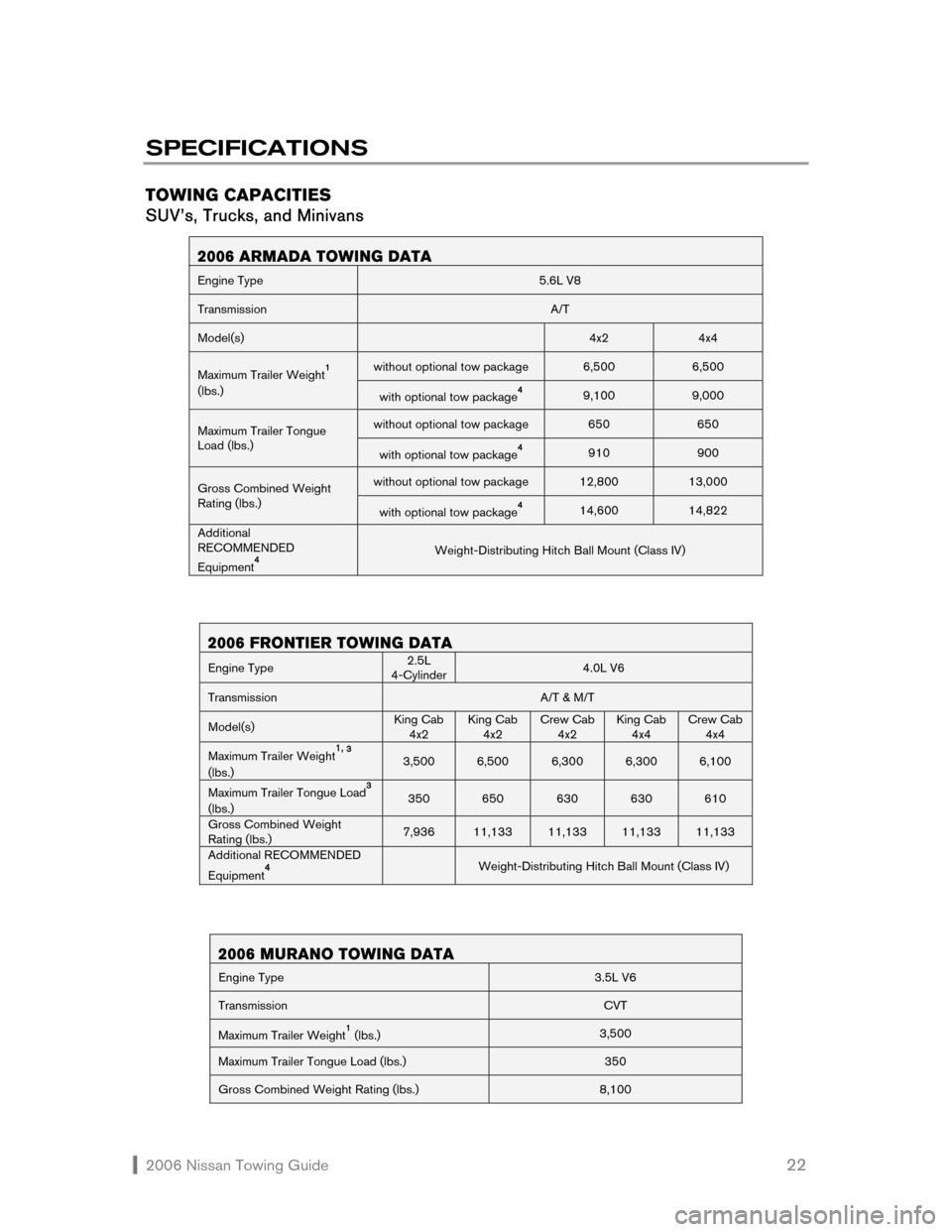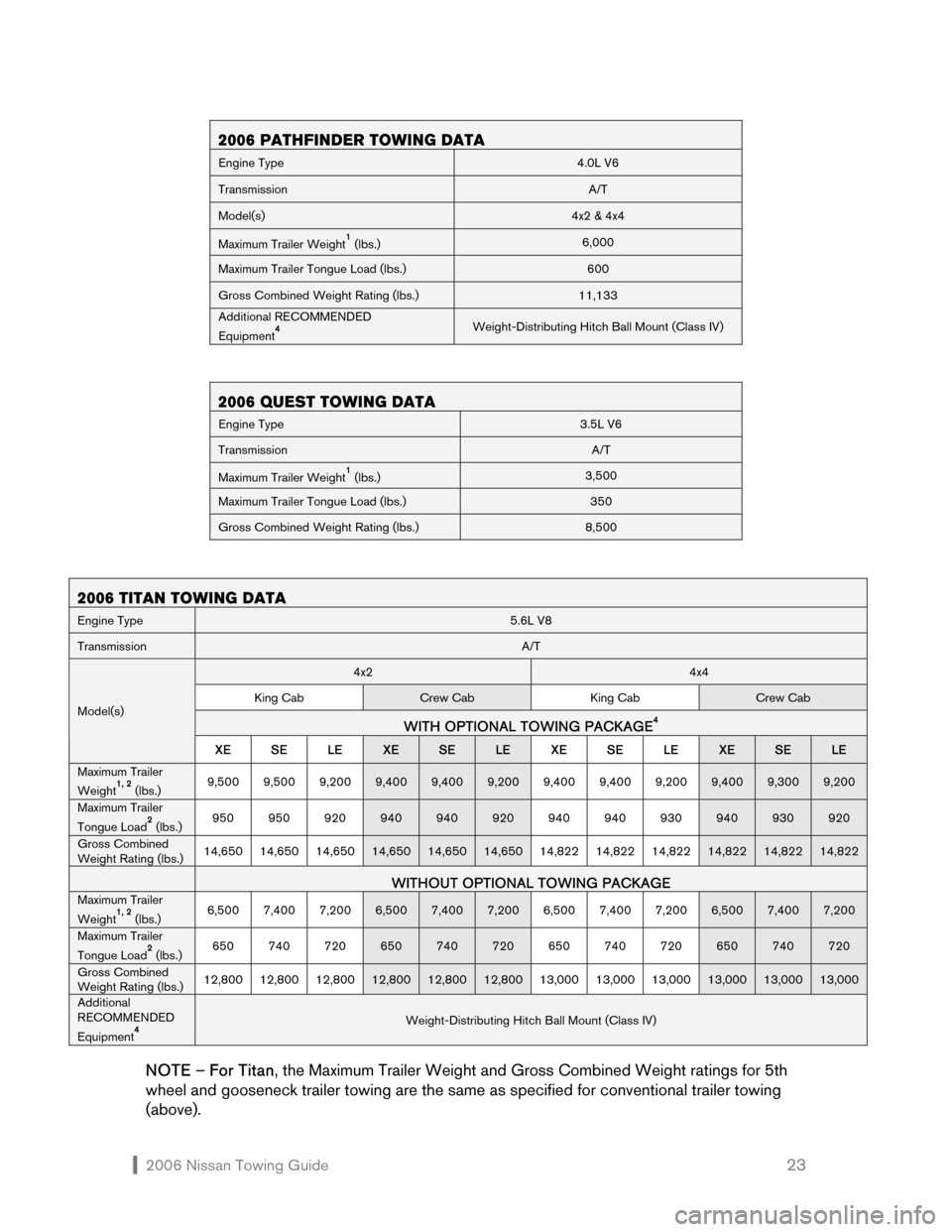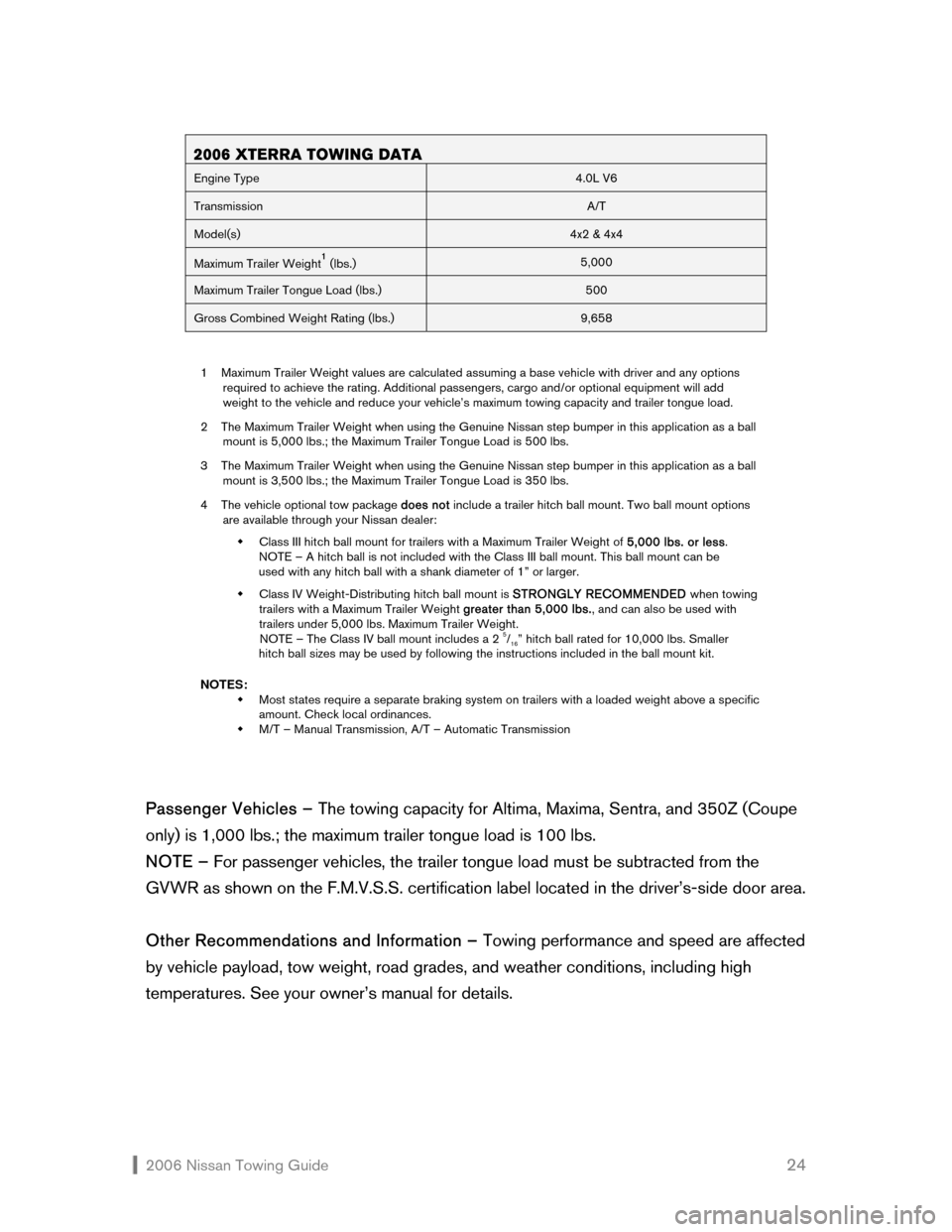engine NISSAN FRONTIER 2006 D22 / 1.G Towing Guide
[x] Cancel search | Manufacturer: NISSAN, Model Year: 2006, Model line: FRONTIER, Model: NISSAN FRONTIER 2006 D22 / 1.GPages: 28, PDF Size: 2.12 MB
Page 2 of 28

2006 Nissan Towing Guide 1
INTRODUCTION
SAFETY IS PRIORITY ONE
Obviously, your first concern should be safety. Your vehicle was designed to be used
primarily to carry passengers and cargo. Always remember that towing a trailer places
additional loads on your vehicle’s engine, drivetrain, steering, braking, and other systems.
Therefore, be certain that your vehicle can meet the demands of the towing application you
have in mind.
Rent or purchase only the highest-quality towing and safety equipment you can find.
Reinforced tow hitches designed especially for certain Nissan vehicles are available from
your Nissan dealer.* Hitches for the other Nissan models should be bought from and
installed by a professional supplier of towing equipment. Finally, it is important to follow the
towing capacity limit set for your specific vehicle, and to ensure that your vehicle is in top
mechanical condition; especially the tires, brakes, suspension, and engine cooling system.
See your owner’s manual for details.
NEVER EXCEED THE ESTABLISHED TOWING CAPACITY
Towing capacities vary from vehicle to vehicle. See the SPECIFICATIONS section of this
guide to view the towing capacities of 2006 Nissan vehicles produced at the time of
Towing Guide publication. Use this data to help select the proper Nissan vehicle to meet
your anticipated needs, and refer to it when renting a trailer or other piece of towing
equipment.
EQUIP YOUR NISSAN FOR TOWING
The frequency and type of towing should also influence the manner in which you equip
your vehicle. If you plan to tow often, either for recreation or work, select the engine size,
transmission type, suspension, and towing capacity that are best suited to your
requirements. This guide can help you select that equipment.
If, on the other hand, your towing will be infrequent, choose the Nissan vehicle and
equipment that best meets your day-to-day needs. Then, be careful not to exceed the
towing capacity on those few occasions when you do tow.
READ THIS GUIDE BEFORE YOU TOW
This guide was designed to provide an overview of safe towing practices. In it you’ll find
information on towing equipment, safety, proper loading and driving techniques, towing tips,
and much more.
It is also a good idea to discuss your towing requirements with either your Nissan dealer
or a professional supplier of towing equipment before you equip your Nissan vehicle for
towing. Finally, there are state and local laws on towing that you should review to ensure
you comply with all regulations.
*Quest tow hitch is factory installed only.
Page 11 of 28

2006 Nissan Towing Guide 10
PREPARING
YOUR VEHICLE
BREAK-IN AND MAINTENANCE SCHEDULE
Nissan recommends that you allow a sufficient “break-in” (500 miles) of both the engine
and drivetrain before towing with your new Nissan vehicle. For the first 500 miles that you
tow a trailer, do not drive over 50 mph.
Keep in mind, too, that towing places higher demands and added loads on vehicle
components, so more frequent maintenance is called for. Your service maintenance guide
provides the accelerated maintenance schedule for towing purposes. Engine oil, filter,
transmission oil, and possibly other fluids should be changed more frequently when towing.
MEASURING VEHICLE WEIGHT
The key to safe, efficient towing has to do with weight. Your vehicle — SUV, truck, Minivan,
or passenger car — is capable of carrying and towing only a certain amount of weight. You
must compare your vehicle’s tow-weight ratings with the combined weight of the vehicle,
trailer, and their contents. This will help ensure that the total weight does not exceed any of
your vehicle’s tow weight ratings. There are four weights to consider when towing:
�Š Gross Vehicle Weight
�Š Gross Axle Weight (Front and Rear)
�Š Gross Combined Weight
�Š Trailer Tongue/King Pin Load
These ratings are based upon normal highway driving and may be reduced if operating in
reduced-traction situations, e.g., slippery boat ramps.
NOTE – Attempting to tow loads greater than the GVWR, GAWR, GCWR, and the trailer
tongue/king pin load specified could adversely affect vehicle handling, braking, and
performance. Damage to your vehicle resulting from overloading may not be covered by
your vehicle warranty.
Page 15 of 28

2006 Nissan Towing Guide 14 TIRE PRESSURE
When towing a trailer, increase tow vehicle tire pressures to the recommended cold
specifications. You’ll find these figures in the owner’s manual and on the tire pressure chart
located in the vehicle. Trailer tire condition, size, load rating, and inflation pressure should
be in accordance with the trailer and tire manufacturer’s specifications.
TOWING
SAFETY
Towing can dramatically alter the handling and performance characteristics of your vehicle.
Plus, it puts increased strain on the engine and drivetrain. Therefore, it is always a good
idea to approach towing from the standpoint of safety — whether you’re purchasing
equipment or actually pulling the trailer.
Always make sure your vehicle’s towing capacity is adequate for the trailer you intend to
tow. Buy or lease only quality equipment, and have it installed only by professionals.
In addition, be certain that you have all of the equipment needed for safe towing,
including safety chains/cables, electric trailer brakes, electric trailer brake controller,
breakaway switch, extended rear view mirrors, and so on. All of these items have been
discussed in a previous section of this guide.
With regard to vehicle maintenance, you should follow a more frequent schedule, and
check fluid levels, pressures, tire condition, etc., more often when on the road. See your
owner’s manual for details.
LOADING YOUR TRAILER
Taking the time to load and balance your trailer properly will improve overall handling and
minimize the strain on your tow vehicle. Incorrectly loaded trailers tend to sway or swing
from side to side, upsetting vehicle handling. Careful loading and balancing can help
eliminate these problems.
As mentioned earlier, conventional trailer tongue load should fall between 10-15% of
the total trailer weight, and king pin load — if using a 5th wheel or gooseneck trailer —
should be between 15-25% of the total trailer weight. Excessive tongue/king pin load can
actually push the vehicle down in back, lifting the front wheels to a point where traction,
steering response, and braking are severely reduced. Insufficient tongue/king pin load can
cause instability, which may lead to “tail wagging” or jackknifing.
Page 17 of 28

2006 Nissan Towing Guide 16 VEHICLE SPEED
Some states have specific regulations and speed limits for vehicles that are towing trailers.
Always obey these ordinances. Remember to reduce your speed in unsafe or less-than-
ideal road conditions or weather. When towing a trailer, braking distances increase while
handling agility decreases. Always leave yourself an extra margin of distance to respond to
emergency situations.
PASSENGERS
Never allow passengers to ride inside a trailer while it is being towed. Not only is this
unlawful in most areas, passengers could be seriously injured during sudden trailer
movement or in an accident. In addition, trailers may allow fumes from the tow vehicle to
leak inside. This could result in carbon monoxide poisoning from the engine exhaust.
VEHICLE MODIFICATIONS
Vehicle modifications — beyond those required for proper hitch installation, wiring hook-up,
and necessary cooling system upgrading — are not recommended for any Nissan vehicle
being used for towing purposes. Changes to the drivetrain, suspension, exhaust systems,
frame structure/unibody, or other vehicle components are not necessary for towing within
the limits described in this guide. These changes may diminish the reliability and longevity
of your vehicle and possibly void warranty coverage as well.
TOOL KIT
It is always a good idea to travel with a special tool kit when towing. In addition to tools, it
should contain flares, a flashlight, emergency reflectors, jumper cables, extra fuses, extra
radiator coolant, oil, and easily replaced spare parts such as taillight bulbs. You should also
carry spare tires for your tow vehicle and trailer, as well as a jack suitable for use on the
trailer. Be aware that not all automotive jacks can be used safely on a trailer.
BEFORE STARTING OUT
Before starting out on a trip, make one last inspection of the tow vehicle and the trailer. Are
the tire pressures correct? Are the safety chains/cables securely in place? Is the cargo tied
down securely? Do all the lights work? Is the coupler properly attached over the hitch ball
and secured using a locking pin? Is the breakaway switch hooked up and functioning
properly? Are vehicle and electric trailer brakes working properly?
Make a checklist of key items to be inspected, and don’t forget the basics. When
towing, vehicle engine oil, transmission oil, and coolant should always be checked before
starting out. Finding a potential problem while in your driveway is better than discovering it
miles from home.
Page 19 of 28

2006 Nissan Towing Guide 18 CORNER MORE SLOWLY
Know your vehicle and trailer capabilities. Entering a sharp corner too quickly or abruptly
can “crack the whip,” whereby the trailer can actually pull the tow vehicle off the road.
Therefore, when approaching a relatively sharp corner, begin braking sooner than you
would when not towing. Do your braking in a straight line prior to the corner, and turn
smoothly into it. In addition, remember to make a wider turn than normal to ensure that the
trailer safely clears the inside of the turn.
When towing a 5th wheel or gooseneck trailer, do not make sharp turns while driving or
backing as the trailer may contact the vehicle and cause damage to both the trailer and
vehicle. A special extended 5th wheel pin box or sliding hitch may be required to provide
additional trailer-to-truck clearance for tight maneuvering.
BACK UP WITH CAUTION
Backing up with a trailer is a difficult maneuver; however, there is a “trick” that can simplify
the procedure considerably. Simply steer with one hand at the bottom of the steering
wheel. To turn the trailer to the left, first move the steering wheel to the left. To turn the
trailer to the right, move the wheel to the right. All movements of the wheel should be done
in small increments. Of course, backing up should be done only at very slow speeds. For
large trailers that obstruct your rearward vision, have someone outside the vehicle act as a
“spotter” to guide you along.
PARK SMART
A tow vehicle and trailer can be an unwieldy combination in a small area, so always try to
park where you will have a relatively easy time maneuvering. Once parked, always block the
wheels on both the tow vehicle and the trailer.
Parking on a slope is not recommended. If, however, you must park on a slope, and your
vehicle is equipped with an automatic transmission, there are some precautions you should
take:
�Š Have someone block the wheels once the tow vehicle and trailer are in position and
being held by the vehicle’s brake.
�Š Next, apply the parking brake, and only then move the gear lever into PARK. If you move
the lever into PARK before blocking the wheels and applying the parking brake,
transmission damage may occur.
HIGH-ALTITUDE PERFORMANCE
An engine will lose about 4% of its performance for every 1,000 feet above sea level that
you travel. If you will be towing in high altitudes, it’s a good idea to allow more time than
usual due to the engine’s reduced performance.
Page 20 of 28

2006 Nissan Towing Guide 19 AUTOMATIC CRUISE CONTROL
Do not use cruise control while towing a trailer.
TOW MODE (IF EQUIPPED)
Tow Mode should be used when the vehicle and trailer weight is at least 75% of the
vehicle GCWR. This mode is most useful when towing a heavy trailer or hauling a heavy
load, particularly when stop-and-go traffic, rolling terrain, or a busy parking lot is involved.
Driving the vehicle in Tow Mode with minimal trailer load will not cause any damage;
however, fuel economy may be reduced, and transmission/engine driving characteristics
may feel different.
HILLS – UPGRADES
As the incline increases, shift down to a lower gear to maintain speed and prevent the
engine from lugging. However, for long and steep grades, do not stay in first gear when
driving above 35 mph or in second gear above 58 mph.* The added weight of a trailer
places an increased load on the engine and cooling system, so monitor your coolant
temperature gauge and automatic transmission fluid temperature gauge (if equipped) very
carefully. At the first sign of overheating, pull to the side of the road. See IF YOUR ENGINE
OVERHEATS later in this section for more information.
HILLS – DOWNGRADES
While going downhill, the weight of the trailer pushing on the tow vehicle may decrease
overall stability. Therefore, to maintain adequate control, reduce your speed and shift
to a lower gear.
When descending a hill, also avoid long or repeated use of the brakes as this reduces
their effectiveness and could cause overheating. Shifting to a lower gear instead provides
“engine braking” and reduces the need to brake as frequently.
IF YOUR ENGINE OVERHEATS
A moderate increase in engine operating temperature is normal when towing a trailer. If,
however, the coolant temperature gauge reading is abnormally high, or if you are
experiencing a significant loss of power, or if you hear unusual engine noises,** the engine
may be overheating and you should immediately take the following steps:
1. Pull your vehicle safely over to the side of the road, out of traffic. Apply the parking
brake, and move the gearshift lever to NEUTRAL (manual) or PARK (automatic). DO
NOT STOP THE ENGINE.
*For Murano, see your owner’s manual for information applicable to your vehicle.
**See your owner’s manual for additional indications that your vehicle may be overheating.
Page 21 of 28

2006 Nissan Towing Guide 20 2. Turn off the air conditioning and, after opening all the windows, turn the heater on to
maximum hot and the fan to its highest speed. The heater core in your vehicle is just
like a miniature engine radiator and will provide an extra cooling surface to help reduce
engine temperature.
3. Run the engine at a fast idle (approximately 1,500 rpm) until the temperature gauge
returns to a normal reading. If the temperature does not drop or continues to increase,
stop this step immediately.
4. Being cautious of traffic, step out of the vehicle and, from a safe distance, look for
steam underneath the engine. If you see steam or leaking coolant, stand clear to avoid
being burned. Shut off your engine immediately and allow it to cool. If there is no steam,
open the hood. Never remove the radiator cap when the radiator is hot. If the cap is
removed under these conditions, hot water under high pressure may spurt out, possibly
causing serious injury.
5. As soon as the engine has cooled to its normal operating temperature, visually inspect
the drive belts for damage or looseness. A loose belt reduces water pump efficiency.
Be careful to keep your hands, hair, jewelry, and clothing clear of the running drive belt
and other moving parts when inspecting the engine and radiator. Also check to see if
the cooling fan is running, and inspect the water pump, radiator, and radiator hoses for
leaks. Keep in mind, too, that if your vehicle is equipped with an electric fan motor, it
may start without warning any time the coolant temperature is high. If you find leaking
coolant, a loose or missing drive belt, or an inoperable fan, turn the engine off
immediately.
6. If no leaks are apparent and all other components appear to be operating properly with
the engine cooled to its normal operating temperature, check the coolant level in the
reservoir tank with the engine running. Add coolant to the reservoir tank if needed. At
this point, if repairs are required, go to the nearest Nissan dealer. See the IN CASE OF
EMERGENCY section of your owner’s manual for additional information on overheating.
NOTE – Armada, Frontier, Pathfinder, Titan, and Xterra vehicles have an engine protection
mode which helps reduce the chance of engine damage if the engine coolant reaches a
specified temperature. The Murano has a high fluid temperature protection mode which
helps to reduce the chance of transmission damage. See your owner’s manual for details.
Page 23 of 28

2006 Nissan Towing Guide 22
SPECIFICATIONS
TOWING CAPACITIES
SUV’s, Trucks, and Minivans
2006 ARMADA TOWING DATA
Engine Type 5.6L V8
Transmission A/T
Model(s) 4x2 4x4
without optional tow package 6,500 6,500 Maximum Trailer Weight1
(lbs.) with optional tow package4 9,100 9,000
without optional tow package 650 650 Maximum Trailer Tongue Load (lbs.) with optional tow package4 910 900
without optional tow package 12,800 13,000 Gross Combined Weight Rating (lbs.) with optional tow package4 14,600 14,822
Additional RECOMMENDED
Equipment4
Weight-Distributing Hitch Ball Mount (Class IV)
2006 FRONTIER TOWING DATA
Engine Type 2.5L 4-Cylinder 4.0L V6
Transmission A/T & M/T
Model(s) King Cab 4x2 King Cab 4x2 Crew Cab 4x2 King Cab 4x4 Crew Cab 4x4
Maximum Trailer Weight1, 3
(lbs.) 3,500 6,500 6,300 6,300 6,100
Maximum Trailer Tongue Load3
(lbs.) 350 650 630 630 610
Gross Combined Weight Rating (lbs.) 7,936 11,133 11,133 11,133 11,133
Additional RECOMMENDED
Equipment4 Weight-Distributing Hitch Ball Mount (Class IV)
2006 MURANO TOWING DATA
Engine Type 3.5L V6
Transmission CVT
Maximum Trailer Weight1 (lbs.) 3,500
Maximum Trailer Tongue Load (lbs.) 350
Gross Combined Weight Rating (lbs.) 8,100
Page 24 of 28

2006 Nissan Towing Guide 23
2006 TITAN TOWING DATA
Engine Type 5.6L V8
Transmission A/T
4x2 4x4
King Cab Crew Cab King Cab Crew Cab
WITH OPTIONAL TOWING PACKAGE4
Model(s)
XE SE LE
XE SE LE XE SE LE XE SE LE
Maximum Trailer
Weight1, 2 (lbs.) 9,500 9,500 9,200 9,400 9,400 9,200 9,400 9,400 9,200 9,400 9,300 9,200
Maximum Trailer
Tongue Load2 (lbs.) 950 950 920 940 940 920 940 940 930 940 930 920
Gross Combined Weight Rating (lbs.) 14,650 14,650 14,650 14,65014,65014,650 14,822 14,822 14,822 14,822 14,82214,822
WITHOUT OPTIONAL TOWING PACKAGE
Maximum Trailer
Weight1, 2 (lbs.) 6,500 7,400 7,200 6,500 7,400 7,200 6,500 7,400 7,200 6,500 7,400 7,200
Maximum Trailer
Tongue Load2 (lbs.) 650 740 720 650 740 720 650 740 720 650 740 720
Gross Combined Weight Rating (lbs.) 12,800 12,800 12,800 12,80012,80012,800 13,000 13,000 13,000 13,000 13,00013,000
Additional RECOMMENDED
Equipment4
Weight-Distributing Hitch Ball Mount (Class IV)
NOTE – For Titan, the Maximum Trailer Weight and Gross Combined Weight ratings for 5th
wheel and gooseneck trailer towing are the same as specified for conventional trailer towing
(above).
2006 PATHFINDER TOWING DATA
Engine Type 4.0L V6
Transmission A/T
Model(s) 4x2 & 4x4
Maximum Trailer Weight1 (lbs.) 6,000
Maximum Trailer Tongue Load (lbs.) 600
Gross Combined Weight Rating (lbs.) 11,133
Additional RECOMMENDED
Equipment4 Weight-Distributing Hitch Ball Mount (Class IV)
2006 QUEST TOWING DATA
Engine Type 3.5L V6
Transmission A/T
Maximum Trailer Weight1 (lbs.) 3,500
Maximum Trailer Tongue Load (lbs.) 350
Gross Combined Weight Rating (lbs.) 8,500
Page 25 of 28

2006 Nissan Towing Guide 24
Passenger Vehicles – The towing capacity for Altima, Maxima, Sentra, and 350Z (Coupe
only) is 1,000 lbs.; the maximum trailer tongue load is 100 lbs.
NOTE – For passenger vehicles, the trailer tongue load must be subtracted from the
GVWR as shown on the F.M.V.S.S. certification label located in the driver’s-side door area.
Other Recommendations and Information – Towing performance and speed are affected
by vehicle payload, tow weight, road grades, and weather conditions, including high
temperatures. See your owner’s manual for details.
2006 XTERRA TOWING DATA
Engine Type 4.0L V6
Transmission A/T
Model(s) 4x2 & 4x4
Maximum Trailer Weight1 (lbs.) 5,000
Maximum Trailer Tongue Load (lbs.) 500
Gross Combined Weight Rating (lbs.) 9,658
1 Maximum Trailer Weight values are calculated assuming a base vehicle with driver and any options
required to achieve the rating. Additional passengers, cargo and/or optional equipment will add
weight to the vehicle and reduce your vehicle’s maximum towing capacity and trailer tongue load.
2 The Maximum Trailer Weight when using the Genuine Nissan step bumper in this application as a ball
mount is 5,000 lbs.; the Maximum Trailer Tongue Load is 500 lbs.
3 The Maximum Trailer Weight when using the Genuine Nissan step bumper in this application as a ball
mount is 3,500 lbs.; the Maximum Trailer Tongue Load is 350 lbs.
4 The vehicle optional tow package does not include a trailer hitch ball mount. Two ball mount options
are available through your Nissan dealer:
�Š Class III hitch ball mount for trailers with a Maximum Trailer Weight of 5,000 lbs. or less.
NOTE – A hitch ball is not included with the Class III ball mount. This ball mount can be
used with any hitch ball with a shank diameter of 1” or larger.
�Š Class IV Weight-Distributing hitch ball mount is STRONGLY RECOMMENDED when towing
trailers with a Maximum Trailer Weight greater than 5,000 lbs., and can also be used with
trailers under 5,000 lbs. Maximum Trailer Weight.
NOTE – The Class IV ball mount includes a 2 5/16” hitch ball rated for 10,000 lbs. Smaller
hitch ball sizes may be used by following the instructions included in the ball mount kit.
NOTES:
�Š Most states require a separate braking system on trailers with a loaded weight above a specific
amount. Check local ordinances.
�Š M/T – Manual Transmission, A/T – Automatic Transmission